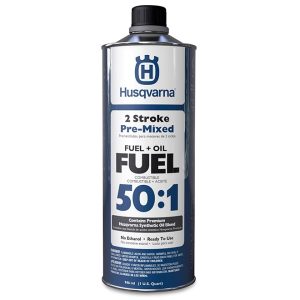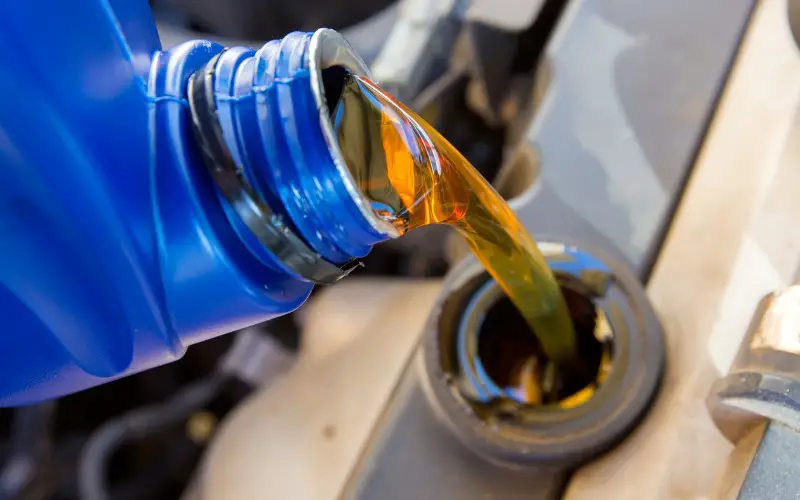Did you just buy a new Husqvarna Weed Eater? Congratulations! Now, I know it’s quite a struggle figuring out the fuel ratio for the first time. Don’t worry, I got all the information you need to know.
The Husqvarna Weed Eater fuel ratio depends on the engine type. If it’s a 2-stroke engine, the ratio is 50:1 oil-to-gas ratio. But if the engine is 4-stroke, you’ll have to lower the ratio to 40:1. You can also find the ratio in the user manual.
Top performance Husqvarna Weed Eater Fuel Mix:
No products found.
Now, are you confused about how to make the fuel mixture maintain this ratio? Follow this article and you’ll learn everything about mixing Husqvarna Weed Eater Fuel.
What Is The Husqvarna Weed Eater Fuel Mix Ratio?
The Husqvarna Weed Eater Fuel mix ratio is 50:1. This means if you’re using Husqvarna Weed Eater, you should use 50 parts of oil (petrol or diesel) and one part of gasoline (unleaded). This is the optimum level of the fuel mixture that’ll help you to achieve maximum output.
However, the ratio actually depends on the type of engine used in the Weed Eater. For example, a 2-stroke Husqvarna will need less fuel than a 4-stroke Husqvarna weed eater. If the engine is 4-stroke, you have to use a 40:1 ratio.
Again, both engines will require separate types of oil. You can’t use the same oil for a 2-stroke Husqvarna weed eater and a 4-stroke Husqvarna weed eater.
If you want to skip the mixing procedure altogether, you can also get pre-mixed fuel for your Weed Eater. Here is my recommended pre-mixed fuel:
No products found.
What Kind of Oil Does a 2-Stroke Husqvarna Weed Eater Take?
A 2-stroke Husqvarna Weed Eater takes two-cycle synthetic engine oil. The company recommends mixing the oil at a 50:1 ratio, given that the fluid level is 2.6 ounces. The ratio stays the same if you use a mineral-based oil for Husqvarna Weed Eater.
However, make sure to check whether the oil meets the lubrication quality standards for JASO-FD, API-TC, or ISO-EGD. You can check the label of the engine oil to find this information.

What Kind of Oil Does a 4-stroke Husqvarna Weed Eater Take?
Now, speaking of the 4-stroke Husqvarna Weed Eater, it takes 4-cycle SAE 30 viscosity engine mower. This mower’s engine oil ratio differs from the 2-stroke Husqvarna Weed Eater.
You have to use a 40:1 ratio in this case. This means this 4-stroke Husqvarna Weed Eater takes approximately 3.2 ounces of oil per gallon of regular gas.
Husqvarna Weed Eater Fuel Mix Ratio in Different Models
Moving on to the popular models of Husqvarna Weed Eaters. Husqvarna 128LD, Husqvarna 223L, and Husqvarna 122C Weed Eater are the most effective mowers.
These weed eaters are all consisted of 2-stroke engines. That’s why all of them require a fuel mix of 50:1 ratio.
| Husqvarna Weed Eater Models | Fuel Mix Ratio |
| Husqvarna 128LD | 50:1 |
| Husqvarna 223L | 50:1 |
| Husqvarna 122C | 50:1 |
You can use both leaded and unleaded gasoline for these models. But make sure the engine oil is mixed at least 2%. And check whether the engine oil is a two-stroke engine oil or not. Or else, the mixture won’t work for a 2-stroke Husqvarna Weed Eater.
What Things to Consider to Maintain Optimum Husqvarna Weed Eater Fuel Ratio?
Now, choosing only a particular oil-to-gas ratio isn’t enough to run the 40:1 or 50:1 ratio in Husqvarna Weed Eater. You should also take care of other things related to the engine oil. Here are the 3 most important factors you need to keep in mind.

1. Type of Engine Oil
Choosing the wrong type of engine oil will just be a waste of your time and money. That’s you have to check which type of engine you have.
If the engine is electric, you should go for mineral-based oil. And if the engine is run on gas, you should choose synthetic-based engine oil.
The type of engine oil also depends on the model variances and the type of terrain you’re working on.
2. Fuel Amount
You should also consider the amount of fuel depending on the area you’re covering. For larger areas, the oil mixture should be more than in smaller areas. If you’re planning to work faster, you’ll require more fuel at a time.
3. Engine Oil Ratio
The engine oil ratio depends on the type of engine. If the engine is old and 4-stroke, you’ll require a 40:1 ratio. But for 2-stroke engines, you’ll need a 50:1 ratio of the fuel mixture.
How to Calculate Fuel Ratio for Husqvarna Weed Eater?
To calculate the fuel ratio for Husqvarna Weed Eater, I’ll follow the US-metric system. So, I’ll measure the oil in ounces and the gas in gallons.
Now, the ideal oil-gas ratio is 50:1. This means if you take 1 US gallon of gasoline you have to add 50 parts oil to the mixture.
For more clarification, simply convert the gallon to ounces.
1 gallon = 128 fl. Oz.
So, if you need 50 parts of oil, you need to divide 128 fl.oz by 50.
128 fl. oz/50 = 2.6 fl. Oz oil/gallon of gas.
So, this means you’ll need to add 2.6 fl. oz. oil in a gallon of gasoline to make the perfect fuel mix (50:1).
Now, depending on the gallon size and ratio, the calculation will differ. An easy way to do this is to multiply 128 fl.oz with the gallon size and you’ll be able to convert gallons to fluid ounces.
Again, for converting ratio, you simply have to divide the gallon size by the ratio required.
Now, if you hate doing math, you can simply follow the table below:
| Fuel Mix Ratio | Gasoline Volume | Required Oil Volume |
| 50:1 | 1 US gallon (128 oz) | 2.6 fl. oz. |
| 40:1 | 1 US gallon (128 oz) | 3.2 fl. oz. |
| 32.1 | 1 US gallon (128 oz) | 4 fl. oz. |
How to Mix Gas for a Husqvarna Weed Eater?
Mixing gas for a Husqvarna Weed Eater is pretty simple. You need to follow only 3 steps to make the perfect Weed Eater fuel mixture. These steps are explained in detail below:
Step 1: Calculate the Required Amount of Fuel
The first thing you have to do is check the user manual of the Husqvarna Weed Eater. You’ll find the exact ratio of the fuel mixture you need to apply. If you’re confused, you can use 50:1 for a 2-stroke engine and 40:1 ratio if the engine is 4-stroke.
Depending on the ratio, you should calculate the exact amount of oil and gas you need. I’ve already shown the calculation in the previous section. So, you can follow that without stressing over doing the math.
Step 2: Measure the Oil and Set Aside
As you’re aware of how much oil you need, you should start by measuring the oil. But first, you have to buy a fresh bottle of mixing oil from the auto parts store. Take a measuring cup and pour the required amount of oil.
Then, pour the measured oil into a clean gas can. Make sure the can isn’t dirty, or else the oil will get contaminated and won’t work for the engine.
Step 3: Mix the Gasoline and Oil Together
Now, you have to add the unleaded gasoline in the oil-filled can. Make sure the proportion of the gasoline and oil is exactly the amount you have calculated before.
Then, seal the can properly and shake it. By shaking the can, the oil and gas will get mixed properly. You should shake the container in a circular motion to avoid gas leaks.
So, there you go! The fuel mixture is ready. You can pour it directly to the Weed Eater tank.
FAQs
What Gas Does Husqvarna Use?
Husqvarna suggests using 89-octane E10 gasoline for every Husqvarna equipment. Usually, any mid-grade gasoline works fine in Husqvarna.
Is Higher Octane Fuel Better for 2 Strokes?
Yes, higher octane fuel is better for 2 strokes. Octanes like 92 and 93 work great in this case. Lower octanes may detonate so you should avoid them. Moreover, make sure the octane is ethanol free.
Do 2 Strokes Burn More Fuel?
No, 2 strokes don’t burn more fuel. In fact, 2 strokes use fuel more efficiently than 4-stroke engines.
Final Words
So, I hope you understand what’s the appropriate Husqvarna Weed Eater fuel mix ratio now.
Remember to keep the ratio intact according to the user manual. If you mix too much or too less oil in gas, the fuel mixture won’t work properly for the engine. Hopefully, by following this article, you’ll be able to make a fuel mixture successfully.
Best of luck!
- 2×6 or 2×8 Sill Plate (Which One is Better for Foundation) - September 3, 2023
- Sill Plate vs Bottom Plate (What’s the Difference) - August 31, 2023
- Craftsman Chainsaw Carburetor Diagram (2023) - June 12, 2023
